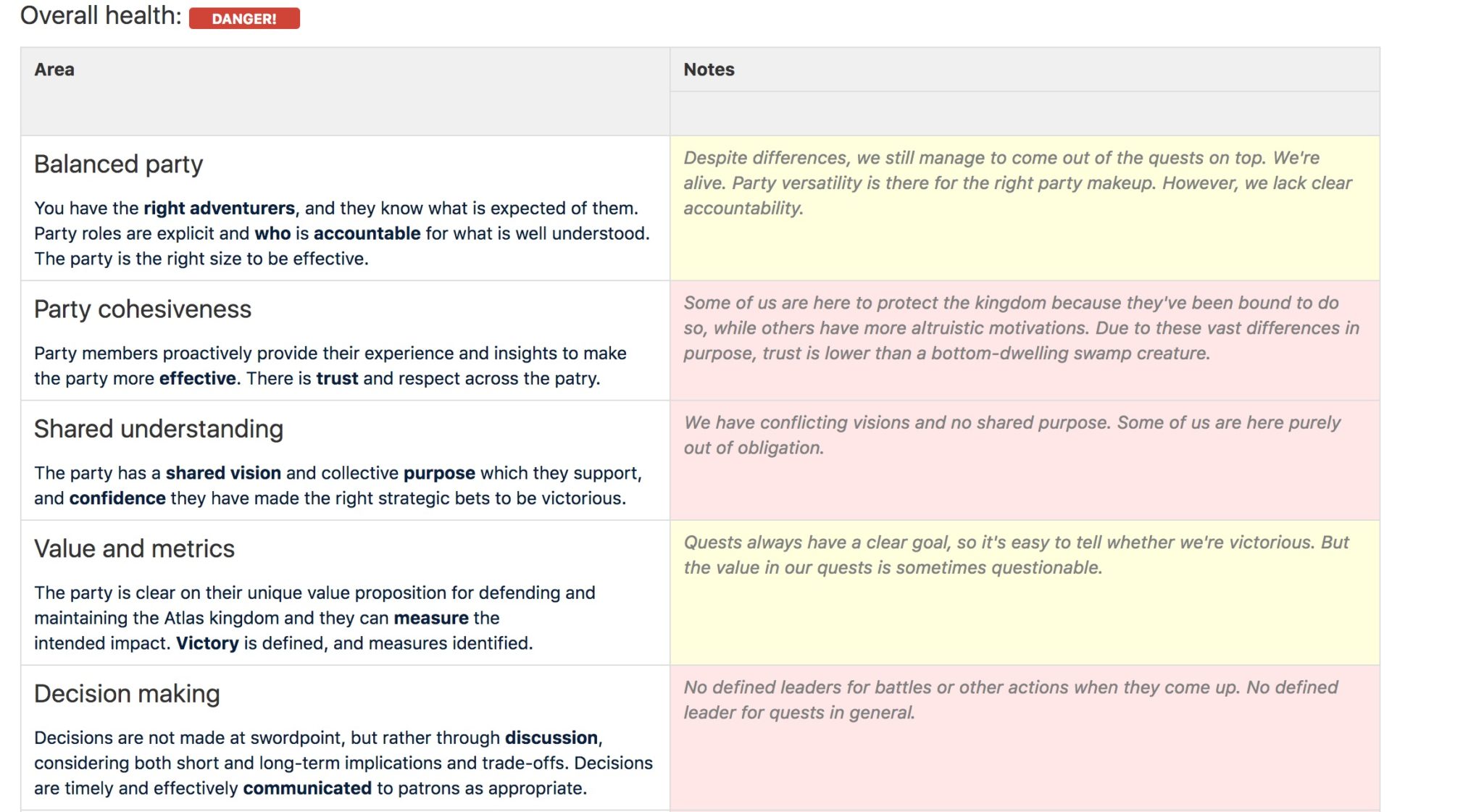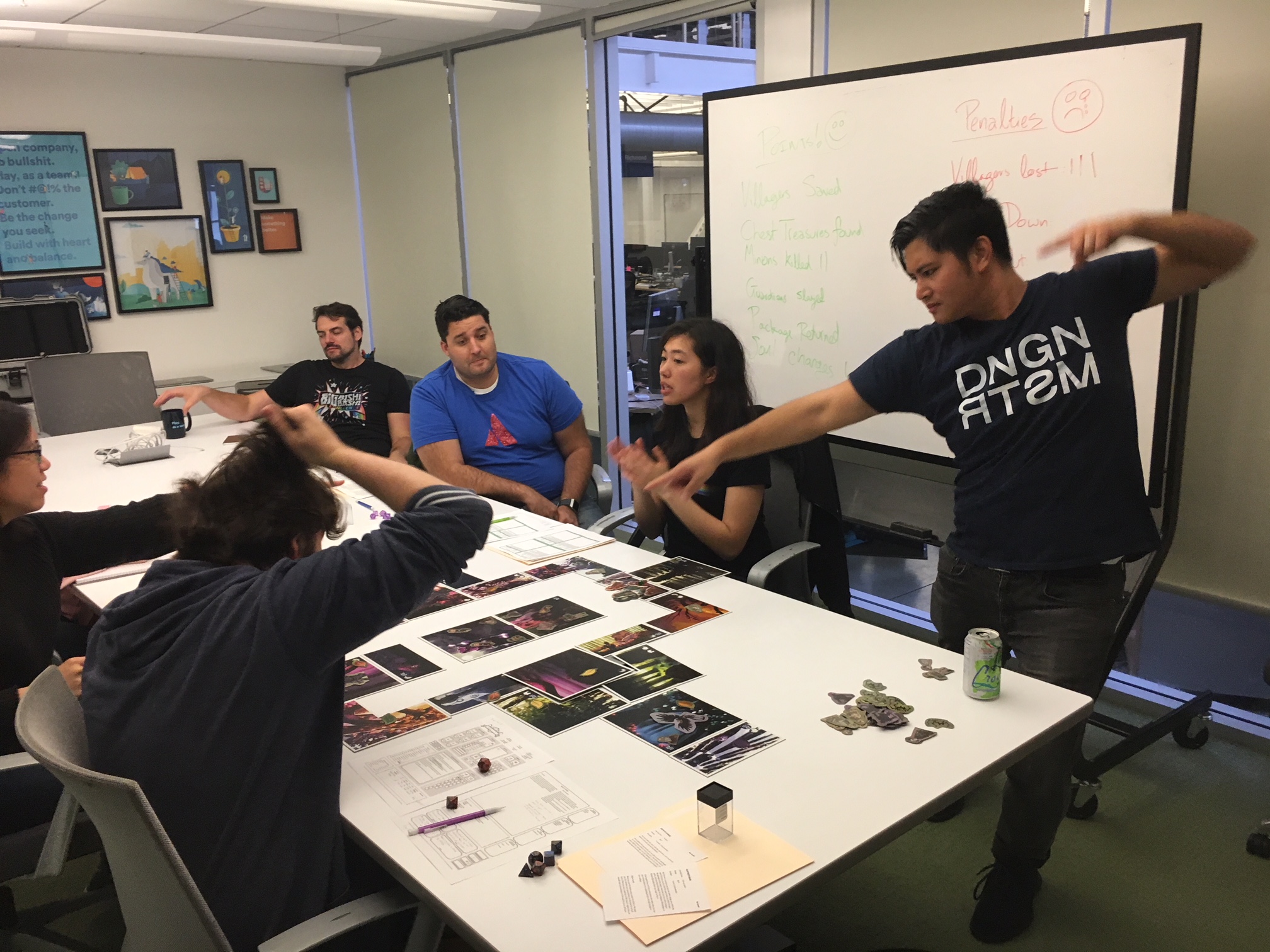I ran an Atlassian Health Monitor with my DnD party
Our DnD party was at each other’s throats, putting the entire campaign at risk. Could the Health Monitor workshops we use with our real-life teams save us?
It was a time of tenuous peace in the kingdom of Atlas. A band of six Atlas Knights met in the Ethereal Plane to assess the health of their party.
Having recently experienced events that tested the party’s beliefs, the Knights were in a time of crisis. Tensions were running high. Several of the members were not on speaking terms. In this state, it was clear they would be unable to carry out their missions to protect the Kingdom of Atlas.
The party had heard tales of a practice that would bring members of a team together to better understand their strengths (and assess their weaknesses). It would prove to be their greatest mission yet.
The party undertook… a Health Monitor.
Atlassians take teamwork pretty seriously. After all, unleashing the potential in every team is what we’re all about. We’ve even been known to take things maybe a liiiiiiitle too far (like when Matt Jeffreys used a few choice collaboration techniques on his kids as an experiment while his wife was out of town).
So when one of the members of our after-work Dungeons & Dragons party jokingly suggested we run a Health Monitor – a practice Atlassian developed and uses to assess and improve the health of our teams – on our DnD party, we laughed.
And then we thought about it.
The purpose of a Health Monitor is to assess how well your team is working together, and what is a DnD party if not a team? As characters, we’d been working together for five months facing “life or death” situations. For the most part, we’d worked well together (up until now, at least). But with party in-fighting at an all-time high, the Health Monitor seemed worth a shot. I mean, it’s served us players well in real life with our real-life teams, so why not?
Time-out for the n00bs
If you’ve never played Dungeons & Dragons before, you’re probably a little perplexed right now. (Or, if you’ve been following along just fine, you’re quite the quick learner. Roll d8 now and apply it to your intelligence bonus.)
Dungeons & Dragons is a role-playing game that uses pencil, paper, a rulebook, your imagination, and a whole lot of goofy-looking dice. Each player designs a character to role play (e.g., elven sorcerer, half-orc ranger, etc.) and together, the group of characters is referred to as a “party”. The party then embarks on adventures, known as “campaigns”, designed and officiated by the Dungeon Master. Using their innate abilities, plus kickass weapons, potions, and other magical items, the party treks, fights, and charms their way across the realm on their way to glory. Or certain death.
It’s basically a real-time “Choose Your Own Adventure” novel designed by theater nerds. You should totally try it.
The monitor of ultimate health-ing
In a Health Monitor exercise, the whole group gets together and rates how the team party is doing in eight areas that are critical to collaboration adventuring. Things like being able to make decisions effectively and learning from past mistakes. For each area, everyone throws out a thumbs up, down, or sideways to indicate how they’re feeling about it. Then you discuss and converge on a group rating.
I’ll be honest: it can be a bit nerve-wracking to put your heart out on your un-armored sleeve like that, even though you know the success of the whole exercise depends on exactly that. And, as I was saying, our party did not enter the Health Monitor on the best of terms.
“We are a group of six. I trust four of you. I respect three of you.” – Duren, son of Daín, dwarven paladin
Two party members – Belphegor and my character, Malaya – had never even met before the Health Monitor. Though Belphegor was unfazed by their unfamiliarity, giving Malaya his usual greeting of unceremoniously attempting to pick her pockets, Malaya would later confess to being hesitant to open up in front of someone she didn’t know.
And having Ser Rowena Daybreaker, a senior Knight of Atlas (and previously known to the party as their quest giver), facilitating the exercise caused some members to choose their words carefully in the presence of the imposing knight.
I’m nervous to say this, especially in front of you Ser Rowena, but I didn’t join the Atlas Knights to blindly serve the Kingdom. I wanted to be a part of something that was bigger than me because of the community I’d belong to. – Malaya, tiefling rogue
As we went through each of the eight assessments in the Health Monitor, it was clear our party was in serious danger. We didn’t even have a shared understanding of the quest we were on, and why we were on it. And decision-making? The only thing we agreed on is the fact that we couldn’t make a decision if we were holding a Rod of Improved Divining!
Part of what makes the Health Monitor so effective is that you check in on a regular basis – typically once a month. At the end of each session, you agree on two areas to focus on over the next month. Checking in regularly builds a sense of momentum and keeps you motivated to improve.
The quest for a healthier party
“I have two… ‘action items’… for this party,” proclaimed Ser Rowena. She turned to Alaya. “I charge you with finding the meaning of trust from each of your fellow knights.” As Alaya protested, Ser Rowena cut her off. “That is an order.”
“And I charge one of you,” she said, turning to Pelora and Duren, “with improving communication amongst your party during decision making.”
“Would you like to share this duty?” Pelora offered to Duren. He immediately refused, leaving the cleric on her own.
Real-life teams may not have a High Knight of Atlas to magically bind team members into fulfilling the action items from their Health Monitors. Nonetheless, it is essential for teams to take action to improve the areas they’ve identified as weak.
Our party soon had a chance to work on our focus areas thanks to a new mini-quest, created by Ser Rowena. The knights were tasked with carrying a soul jar into the center of a dungeon plagued by enemies. They would need to coordinate to activate the magic switches, which, when flipped at the correct time, would open the passage to the dungeon’s center.
The task necessitated a balance of communication and quick thinking, as well as trust in our fellow party members. Sadly, the quest itself proved impossible for us, but we were proud of how we planned our approach and communicated clearly.
So while the party was ultimately defeated in the depths of the dungeon, we were victorious in health.
I appreciate the communication our party had. – Pelora, human cleric
asdf
asdf
asdf
I wish I could’ve gotten that chest open. – Belphegor, tiefling rouge
Yeah, it’s a little goofy. But it was fun. Plus, now that our party is better at communicating and generally more effective at GQD (getting quests done), our DM has to work a little harder to foil us. Payback is in the eye of the Beholder, if you know what I mean.
Want to give it a try? Here’s a template you can use with your DnD group.
Team Health Monitor tips for every-day heroes
Even though the players in our group already had experience with the Health Monitor before this, doing it in character as an adventuring party taught us a few new things that apply in real life.
- Whatever vibe is running through your team when you begin a Health Monitor session will influence your experience with it. And that’s ok. Just adjust your expectations accordingly.
- Having a good facilitator will improve the level of honesty in the room and your willingness to be vulnerable in front of your peers. Even more so if the facilitator is someone the team respects, but isn’t actually on the team and therefore not weighing in on the ratings.
- Even with an excellent facilitator and decent levels of trust amongst teammates, it can take a few Health Monitor sessions before people really feel comfortable opening up.
- Taking steps to improve your weak areas is where the real value lies. If you’re going to be all talk and no action, don’t even bother.
- Even if a project fails to meet its goals, if your team showed improvement on your focus areas, you should celebrate that.
. . .
Does your team have what it takes to take on new adventures and band together in the quest for workplace glory? Find out by assessing yourselves against eight attributes common amongst healthy, high-performing teams. Swords optional. (In fact, best to just leave them at your desk.)
Learn how to run a Health Monitor
Character images courtesy of: dandwiki.com, worldanvil.com, the-rp-fear.wikia.com, pinterest.com, artstation.com, and obsidianportal.com.














































